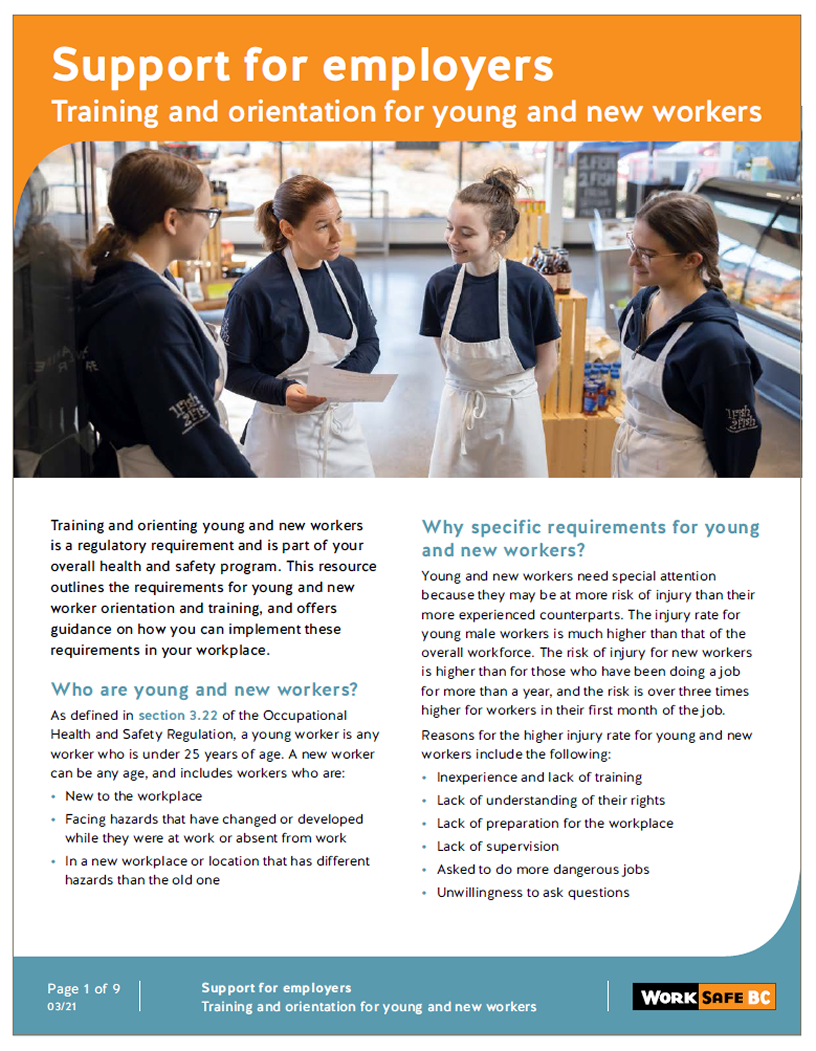Training & orienting workers
As an employer, you're responsible for ensuring your workers are properly instructed and trained on how to do their work safely. This includes providing safety orientation for new and young workers, and training them on the basics. It also includes training workers on their specific tasks, and providing supervision and ongoing training so they continue to work safely.
Effectively training and orienting your workers is key to helping them stay safe on the job — and preventing life-changing and costly work-related injuries. The following three basic steps can help ensure your workers are properly trained and oriented:
-
1
Safety orientation and the basics
Whenever you hire new workers, it's important that you incorporate safety into their orientation to the worksite before they start working. Not only will this help them understand how to do their jobs safely, it'll let them know that you take safety seriously.
Using a checklist can help make the orientation easier and more thorough. Plus, you can keep the checklist on file as a record of employee training — another one of your requirements.
There are a number of orientation topics you can cover, but there are three that must be included in every orientation. These are described briefly below.
Rights and responsibilities
Everyone has a right to a safe workplace — and everyone has a role to play in keeping it safe. It's important that new workers understand what their rights and responsibilities are, as well as the rights and responsibilities of supervisors and employers.
Workplace hazards
Workers need to to be aware of hazards so they can let their supervisor or employer know if there are unsafe conditions that need to be fixed. It's important that you identify all hazards to workers — even if they seem obvious. Also explain what systems or measures you've put in place to minimize the hazard.
Safe work procedures
There are probably tasks in your workplace that require specific safe work procedures — for example, locking out machinery or picking up discarded needles. Workers must be trained in these step-by-step safe work procedures. Don't just tell them the steps or have them read the instructions; make sure to verify that they truly understand how to do the task safely.
Learn more about developing safe work procedures in our health and safety program section.
-
2
Train workers for their specific tasks
It's important that your workers have supervised, hands-on training in the tasks they'll perform — before they start a job. Specifically, you need to ensure workers are trained in how to do the following:
- Perform tasks safely
- Operate machines and equipment safely
- Use and maintain any required personal protective equipment
- Follow safe work procedures
When training new workers, here's a general procedure you can follow:
- Provide an overview of each task, including if there are any safety precautions and safe work procedures.
- Demonstrate and describe the task, going through the steps slowly.
- Observe the worker on the job and check his or her progress.
-
3
Provide supervision and ongoing training
The most important part of training is following up. Make a point to regularly observe your workers to check that they're still following safe work procedures. Conduct informal discussions or crew talks with workers to talk about specific health and safety issues. Encourage workers to provide feedback.
Training records
You're responsible for maintaining records of the education, training, and supervision for each worker. There are several sample checklists that can help you with your orientation and training, as well as serve as documentation of training that's taken place.
Supervisor training
There may be workers in your organization that are actually supervising their co-workers, even though they may not be called a supervisor. Before you ask any workers to take on supervisory tasks, you need to ensure they've been trained on and understand the supervisor's responsibilities for health and safety.
Highlights
- Revised safety poster shows workers how to stand out safely around mobile equipment and vehicles Published on: April 24, 2023

